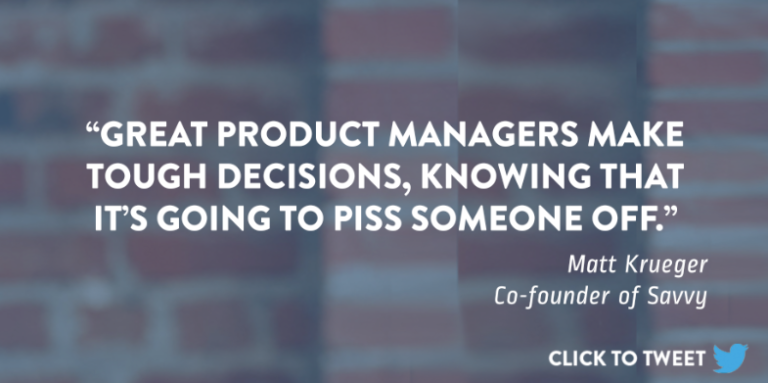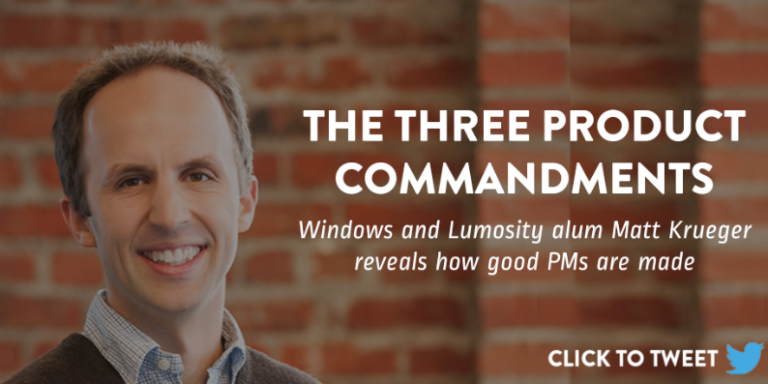A Windows and Lumosity alum issues his three product commandments
It almost looked like a mistake, but it changed the course of his career.
Matt Krueger’s work on the Windows team had always erred toward the marketing side of things. But he’d just been assigned a project that would give him the chance to actually build a product. Long wanting to reside in product, Matt had been locked out by Microsoft’s insistence that PMs know how to code.
“Early on it was implanted in me that if you wanted to really have an impact on the product, you had to be more on the engineering side,” he said. “I was always personally interested in building and solving problems on the product side, but without the ability to code, it was really difficult to go toe-to-toe with engineers.”
At the time, Matt couldn’t code, but he was a process phenom. Because of his ability to coordinate people and drive them toward a cause, Matt eventually ascended the product ranks at Microsoft and eventually Lumosity, where he became VP of Product. Now he’s co-founded Savvy, but even as his responsibilities multiply, his heart remains in product.
Matt ultimately did learn to code, but that’s not what made him a great product leader. He believes great PMs do 3 important things—so ask yourself:
- Can you listen?
- Can you make tough decisions and live with them?
- Can you tell compelling stories to different audiences?
These are the traits that make exceptional PMs.
The first thing a good product manager must do is listen more. Also, listen better.
Matt’s very easy to talk to, but the kind of listening he advocates isn’t just smiles and nods. It’s proactive in nature, and sometimes even aggressive.
“I use ‘listen’ very broadly,” he said. “Whether it’s through an interview, a focus group, or a survey, you have to listen to what the customer is trying to do and what their pain points are, especially the ones they can’t express.”
The PM role originated because understanding problems is hard. True understanding requires not only listening to what’s said, but also what isn’t. When Matt sits down with a customer or an engineer, he makes sure to hear what’s in between the lines.
If you accept that coding is a skill that should be on every PM’s utility belt, listening is why. It’s hard to move beyond the literal words and hear an engineer’s actual problem when you’re not fluent in their language. And you probably wouldn’t be asking that much follow-up.
“You have to listen to the engineers actually building the product,” Matt said. “That’s not just firing Slack messages back and forth, but deeply understanding what’s possible, why something may not be possible, whether you could tweak something that makes it more ideal.”
One of Matt’s techniques for listening is the famous Five Whys. Another is to ask questions until you’ve reduced the problem to its barest state: Is it A? Or B? If we were to build this feature, hypothetically, what would be the first thing that we need to do? Why’s that? Say, we want to rebuild the payment system—what’s the hardest part?
These shouldn’t be Yes/No questions. Ideally, these conversations are best in person.
“These can sometimes be stupid, broad questions,” Matt admitted. “But it starts a dialogue. It gets them talking, and you have to pay attention to what’s negotiable and what’s not.”
Along with listening to customers and colleagues, you have to listen to data. In that case, aggression still applies: PMs can’t passively watch numbers roll in; they need to sift through it and discover patterns.
So, what is all this listening for?
You’re unlikely to find anyone in the technology sector more friendly and good-natured than Matt Krueger, so try not to take this next commandment personally.
The fact is if everyone’s happy, not enough is at stake.
“Great product managers make tough decisions, knowing that it’s going to piss someone off or make someone upset,” he said. “If you try to please everyone as a product manager, you will crash and burn.”
From where Matt stood, Windows had grown stagnant because the company was happy to rest on its laurels and avoid tough decisions.
“It was eminently clear to me that we were living through the innovator’s dilemma,” he said. “We had a cash cow, and couldn’t bring ourselves to make the changes necessary to innovate if it meant foregoing income in the short-term.”

Instead of innovative changes, the Windows team settled for optimizations that felt agreeable, if useless. The product folks wanted their operating system to be lovable.
“For example, we wanted people to love the operating system the way we did—it was our baby,” Matt said. “But no one loves an operating system.”
Barring a miracle, consumers weren’t going to fall hard for an operating system, and product managers hold themselves to roadmaps, not miracles. The most Windows could ultimately accomplish was providing a powerful base for the types of applications that consumers did love.
“If you’re a utility, then by God be the best utility you can be,” Matt said. “We should’ve gotten out of our own way and enabled developers to innovate instead of, for example, trying to make the start menu sexy.”
Innovating gets harder as you become more successful; not less. From the second Matt joined Lumosity as a product manager, he made tough decisions, but those choices didn’t affect nearly as many people as the ones he made as VP. As it becomes more difficult to make tough decisions, so too does it become more important.
“Someone has to make that call,” he said. “If I do it, I might be wrong—we’ll see. There’s some bravery in it.”
The bravery, of course, lies in the blowback. And that’s where Matt’s third commandment comes in. Good products managers are ready to explain themselves.
At every turn, you need to be able to effectively communicate your decisions and mobilize others to your cause. You’ve listened; you’ve acted; now you need to explain. One of the best ways to explain something is through narrative.
Anyone can tell a single story, though. PMs need to tell multiple, and perhaps more strategically, different versions of the same story to several audiences.
“You need to communicate and explain your tough decisions to the team so that they are bought in,” Matt said. “Another thing I saw at Microsoft—which is what bad PMs do—is spit out decisions and expect the team not to question it.”
As the VP of Product at Lumosity, Matt had a few different audiences: his own team, the board of directors, and the company at-large. Each group essentially wanted a product vision and plan that would give them faith in the future.
But facing three different audiences, Matt’s product vision had to be prismic. At this angle, certain qualities were emphasized. At another, others were.
“When you’re talking to the board, it might be very strategy-focused, very analytical, and very dry, but it’s still a story you want them to buy into,” he said. “For the entire company, it’s about tying product vision to the overall mission. People didn’t join Lumosity because it was growing or because it had a great office, but because they believed in the mission.”
And then there’s Matt’s PM team.
“When you’re talking to the PM team, you give some amount of the larger picture, but it’s also important to articulate the short-term goals we’re building toward.,” Matt said. “The whole team needs to be on the same page with where we’re trying to go,. how we can get there, and how we’ll know when we’ve arrived.”
The more Matt has listened to problems and been forced to make tough decisions, the more he’s had to effectively communicate his actions. But continually running through this cycle has helped him carry the weight of a product vision. He’ll have to carry these lessons forward as he leads not only a product team but a company
It turns out these 3 traits are critical at every size of company, from large enterprises to nascent startups.
Matt’s newest endeavor is Savvy, a service that lowers your bills and invests the rest. Right now, they negotiate a lower rate on your cable bill on your behalf and save people an average of $300 per year.
“My co-founder Sushmita Subramanian and I wanted to help people become more financially healthy,” he said. “We’re still in beta, but we’ve been able to save people thousands of dollars on their bills. Whether it’s $300 on cable, $1000 on my sister’s insurance, or $12,000 on my dad’s mortgage – it all adds up. When you take those savings each year and invest them it becomes life-changing.”
With just the two founders doing everything right now, there’s no need for roles or titles. But the job of founder or CEO is something he was prepared for by the product manager role. It’s a cliche that PMs are the “CEO of a product” but there’s some truth to it when you look at the responsibilities and skills required.
“You’ll always have successful CEOs with lots of different backgrounds, but I do think that the product skillset is a good fit,” he said. “The practice of having to take in a variety of inputs and then solving big problems lends itself to what a CEO ultimately ends up doing day to day.”
The three characteristics are every bit as important to him in his new role as they were when he was a PM.
If Savvy is successful, Matt and Sushmita will have to build a strong team and empower them to make decisions. It won’t be an easy journey and, as every founder knows, there will be as many lows as there are highs.
But at least when it comes to hiring PMs he’ll know what to look for: people who listen, make decisions, and communicate through great stories.



